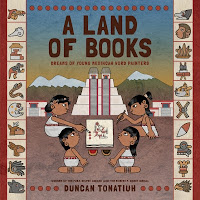After my own years in school ended and before my teaching days, I didn’t take much notice of themed months of the year. For instance, did you know that November is National Native American Heritage Month in the United States? I didn’t! Luckily it’s been mentioned in several teaching and book publishing newsletters I subscribe to. What I find helpful is that those newsletters often come with book recommendations or lists included – titles that I can add to the shelf to make my classroom library (or even just personal library!) a little more inclusive and representative of my students and the US as a whole. One book I haven’t seen on any lists but want to make sure you know about is the young adult graphic novel anthology Woman in the Woods and Other North American Stories, edited by Kel McDonald, Kate Ashwin, & Alina Pete. It is the fifth installment in the Cautionary Fables & Fairytales series, and if the others are anything like this slim volume, they are treasures!
Tricksters? Rabbits? Rougarou?
Shapeshifters so frightening you shouldn't speak their name? That's just the start of this collection of folklore from the Indigenous people of North America, retold in comic form.
The fifth volume of the Cautionary Fables and Fairytales graphic anthology series is a thrilling, funny and totally unexpected take on stories spanning North America, with loads of traditional stories from Indigenous Nations such as the Taíno, Navajo, Odawa, and more!
The Woman in the Woods is an excellent collection of Native American legends and stories from across North America. While the title of the series is Cautionary Fables & Fairytales, these are no gory, fright-filled stories. Instead, they read like the sort of tales you’d share around a campfire – a little bit of cultural history, a dash of tall tale, and an uncanny thing that happened to someone you know/one of your ancestors, etc. They range from a creation tale that deals with two spirit and trans identity to a diving encounter with a monstrous octopus on the sea floor of the Puget Sound.
While each chapter was written and illustrated by a different duo (and is handed down from/told according to different indigenous peoples and traditions), a universal theme running throughout all of them is acceptance of difference, the other, and the strangeness that is present in the world. A couple of the stories deal with some element of gender nonconformity, and others speak to a diverse understanding of how humans function in society. Some are teaching tales; some merely point to the unexplained and ask the reader to make of it what they will. Some aim to make the reader uncomfortable, or to challenge their disbelief.
The standout comic of the collection is the Métis story The Rougarou by Maija Ambrose Plamondon, illustrated by Milo Applejohn. This story’s length (a bit longer than the others included in the volume), gorgeously detailed line art, and theme of transformation all combine to create an exceptional entry. I will be keeping an eye on Plamondon & Applejohn’s work in the future!
The art throughout the volume is in black and white and styles vary from artist to artist. Several employ strong or thick line work and varying shades of gray and black for a feeling of heaviness and (at times) menace. While the standout is mentioned above, there was no weak link – the writing and art in the volume is strong all the way through.
In all, The Woman in the Woods is a varied anthology in terms of setting, societies, norms, and time periods. It’s an interesting collection, and an important one for libraries large and small!
Recommended for: fans of fables and fairy tales, especially those adapted into
graphic novel format, anyone looking to diversify their shelves with more
indigenous American literature, and readers ages 10+ who are interested in
campfire tales they may not have heard before!















